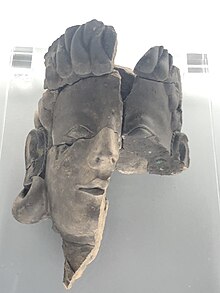Turuñuelo

El Turuñuelo, also called Casas del Turuñuelo and El Turuñuelo de Guareña, is an archaeological site in Guareña, province of Badajoz, Spain. It corresponds to the late Tartessian culture developed in the Middle Guadiana Valley in the southwestern Iberian Peninsula in the 5th century BCE after the downfall of the Tartessian archaeological culture's main core around the Guadalquivir valley by the end of the 6th century BCE.[2] It consists of a huge 2,500-year-old two-floor building which was ritually set on fire and buried after a hecatomb-like ceremony was performed.[3]
The mound under which the building is located was already known since the 1980s.[4] The earliest digging works began in 2015.[5] As of 2021, there were another 12 similar structures identified in the region, of which only two, Cancho Roano (Zalamea de la Serena) and La Mata (Campanario) had been excavated.[6] The site was declared bien de interés cultural in May 2022.[5]
The six last steps of the courtyard stairs in the site singularly display the use of lime mortar.[7]
Sculptural representations
[edit]In April of 2023, several sculptures that represent the first human representations of Tartessian culture were discovered. They were found during the fifth excavation campaign carried out by a CSIC team at the Casas de Turuñuelo site.
These are five unusual anthropomorphic busts dating from the 5th century BC, and they represent a paradigm shift in the iconic interpretation of Tartessian culture, considered as one of the earliest of the Western civilizations. Until then, it was believed to be aniconic because it represented divinity only through animal or plant motifs, or through betyls (sacred stones). Esther Rodríguez, from the team at the Mérida Institute of Archaeology, mentioned at the press conference held on the same day that "This discovery changes the reading of art history."
Lady of Guardamar, from the Phoenician archaeological site of Cabezo Lucero in Guardamar del Segura in Alicante province, Spain, shows some parallels to the Turunuelo sculptures. It was discovered in 1987, and is dated c. 400-370 BC.[8] Another such representation is the Lady of Elche.
Various hypotheses are being considered regarding the final flight of the Tartessians from this area of the south-west of the peninsula: either an imminent invasion by Celtic peoples or an extreme climatic phenomenon such as a flood or drought. The current objective of the Construyendo Tarteso team - a project of the State Research Agency - is to find the eastern access to the remains of this two-storey building, that was discovered at the site, considered to be the best preserved in the western Mediterranean.
According to the CSIC, this site is unique due to its "excellent state of conservation". The excavated building has allowed the researchers to discover "construction techniques and architectural solutions that until now had not been documented in a Tartessian site".
In this region of southern Spain, the Tartessian culture was born around the 9th century B.C. as a result of hybridization between the Phoenician settlers and the local inhabitants.[9]
References
[edit]- ^ Vigario, David (8 April 2023). "El "insólito" descubrimiento arqueológico de Turuñuelo: las primeras representaciones humanas de Tarteso". El Mundo.
- ^ Berrocal-Rangel, Luis; Celestino Pérez, Sebastián; Rodríguez González, Esther (2020). Marín-Aguilera, Beatriz; Gleba, Margarita (eds.). "Textiles and Rituality in the Late Tartessian Culture of the Guadiana Valley". Sagvntvm. 20. Valencia: Departament de Prehistòria, Arqueologia i Història Antiga de la Universitat de València: 113. ISSN 2253-7295.
- ^ "El Turuñuelo se ha convertido en un ejemplo excepcional para el estudio de la arquitectura tartésica". Hoy Guareña. 12 October 2016. Retrieved 17 April 2017.
- ^ Celestino Pérez & Rodríguez González 2019, p. 343.
- ^ a b "Meritxell Batet destaca el yacimiento tartésico de 'El Turuñuelo' en Guareña y la "colaboración entre administraciones"". Europa Press. 17 September 2022.
- ^ Macías, C. (12 July 2021). "El Turuñuelo: la misteriosa escalera extremeña que podría cambiar todos los manuales". El Confidencial.
- ^ Celestino Pérez, Sebastián; Rodríguez González, Esther (2019). "Un espacio para el sacrificio: el patio del yacimiento tartésico de Casas del Turuñuelo (Guareña, Badajoz)". Complutum. 30 (2). Madrid: Ediciones Complutense: 362. doi:10.5209/cmpl.66337. hdl:10261/213982. ISSN 1131-6993.
- ^ "Historia-Guardamar". Archived from the original on 2009-04-13. Retrieved 2013-06-13. Historia Guardamar
- ^ APR 19, 2023 -- Discovery of Tartessian sculptures turns study of Iberian pre-Roman culture on its head. english.elpais.com
- Tartessos
- Buildings and structures completed in the 5th century BC
- 5th-century BC disestablishments
- Burned buildings and structures in Europe
- Archaeological sites in Extremadura
- Prehistoric sites in Spain
- Bien de Interés Cultural landmarks in the Province of Badajoz
- Guadiana
- History of the province of Badajoz
